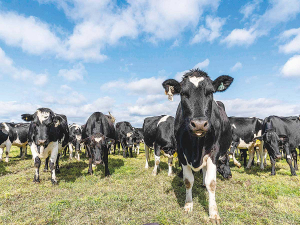Ensuring your cows have the best mating this season
Hit the ground running this mating with these foundations for success.
 With mating season around the corner, there's no time for guesswork or getting herd nutrition wrong, according to GrainCorp Feeds' technical support manager Ken Winter.
With mating season around the corner, there's no time for guesswork or getting herd nutrition wrong, according to GrainCorp Feeds' technical support manager Ken Winter.
With mating season around the corner, there's no time for guesswork or getting herd nutrition wrong, according to GrainCorp Feeds' technical support manager Ken Winter.
With changing pasture quality, he says making sure cows are getting adequate metabolisable energy (ME) is perhaps this season's most pressing issue.
"At this time of the year, the energy demands on a cow are at an all-time high. The physical exertions of pregnancy, calving and now milk production have taken a toll on her energy reserves.
"It is critical to bring her energy levels up, not only for milk production, but for reproduction. If a cow's energy intake is lower than her output, her body will find the missing calories from within her own system."
Body fat and protein will be mobilisd to make milk, but the cost of doing so will be high. Body condition will be lost and so will her ability to conceive. I've seen it happen many times.
"The most common mistake I see at this time of year is animals being fed too little. Some farmers underestimate the genetic potential of their herd, which leads them to underestimate feed requirements. Unfortunately, many cows will head into mating undernourished, which can adversely affect conception rates."
There are solutions, but farmers need to know how much to feed their cows to meet their cows to meet their genetic and fertility requirements.
Reaching a target Body Condition Score (BCS) of 5 to 5.5 before calving is ideal. Ensuring a cow's rumen is fit and healthy prior to calving and stimulating a good appetite post-calving are two key factors. Ken has seen good results when a series of practical measures are taken.
"Underfed animals need an energy break. One of the best things a farmer can do is to milk once-a-day over the colostrum period, for 4-5 days after calving and even longer if necessary. Not only will this take less out of the cow, it helps protect the integrity of the liver which in turn means better feed conversion efficiency. More energy from every bite can lead to improved immune function, performance and appetite.
"The other crucial part is bringing in additional feed to fill the energy gaps. I always start on-farm to see what resources are already available. Farmers often come unstuck because they haven't built up enough feed cover and there isn't any extra to turn to. With a bit of planning, we can fix that for next season."
With the current situation in the European farm machinery market being described as difficult at best, it’s perhaps no surprise that the upcoming AgriSIMA 2026 agricultural machinery exhibition, scheduled for February 2026 at Paris-Nord Villepinte, has been cancelled.
The Meat Industry Association of New Zealand (MIA) has launched the first in-market activation of the refreshed Taste Pure Nature country-of-origin brand with an exclusive pop-up restaurant experience in Shanghai.
Jayna Wadsworth, daughter of the late New Zealand wicketkeeper Ken Wadsworth, has launched an auction of cricket memorabilia to raise funds for I Am Hope's youth mental health work.
As we move into the 2025/26 growing season, the Tractor and Machinery Association (TAMA) reports that the third quarter results for the year to date is showing that the stagnated tractor market of the last 18 months is showing signs of recovery.
DairyNZ chair Tracy Brown is urging dairy farmers to participate in the 2026 Levy vote, to be held early next year.
Beef + Lamb New Zealand (B+LNZ) is calling for nominations for director roles in the Eastern North Island and Southern South Island electoral districts.
OPINION: Microplastics are turning up just about everywhere in the global food supply, including in fish, cups of tea, and…
OPINION: At a time when dairy prices are at record highs, no one was expecting the world's second largest dairy…